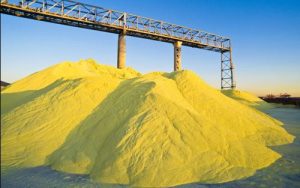Sulphur Overproduction
Sulfur overproduction can occur when the supply of sulfur exceeds the demand for various reasons. Some possible factors contributing to sulfur overproduction in Canada or any other country include:
- Fluctuations in demand: If there is a decrease in demand for metals or other products that require sulfur, it can lead to excess sulfur production. Economic factors, changes in industry needs, or shifts in international trade can all affect demand levels.
- Imbalance in supply and demand: If sulfur production capacity increases significantly without a proportional increase in demand, it can result in overproduction. This can happen due to expansions in mining operations or the development of new sulfur extraction facilities.
- Export restrictions: If there are restrictions on sulfur exports from Canada’s major trading partners, it can lead to an accumulation of excess sulfur within the country.
- Technological advancements: Improvements in mining and processing technologies can increase the efficiency of sulfur extraction, leading to higher production levels. If these advancements outpace the growth in demand, it can result in overproduction.
- Environmental regulations: Changes in environmental regulations, both domestically and internationally, can impact sulfur demand. Stricter regulations on emissions, for example, may require industries to reduce their sulfur usage, leading to a decrease in demand.
Canada’s Sulphur production
Preliminary figures show Canadian sulphur production was roughly 8.1 Mt in 2008, an 8% decrease compared to 8.8 Mt in 2007. The decrease was from natural gas processing. Canadian elemental sulphur output in 2008 was 6.9 Mt, a decrease of 6.9% compared to 7.6 Mt in 2007. An additional 1.1 Mt of sulphur equivalent, in the form of sulphuric acid and liquefied sulphur dioxide, was recovered from the smelting of metals. Canada exported approximately 7.6 Mt in 2008, a decline of 5.2% compared to 8 Mt in 2007. The decline occurred in elemental sulphur with exports of 6.8 Mt in 2008, down 6.4% from 7.3 Mt in 2007. Exports of sulphur in other forms (SOF) amounted to 776 000 t of sulphur equivalent.
Sulfur production in Canada in 2022 was 4.9 Mt.
In December 2022 Canada‘s Sulphur exports accounted up to C$49.2M and imports accounted up to C$563k, resulting in a positive trade balance of C$48.6M. Between December 2021 and December 2022 the exports of Canada‘s Sulphur have increased by C$8.89M (22.1%) from C$40.3M to C$49.2M, while imports decreased by C$-31.9k (-5.36%) from C$595k to C$563k.
Sulphur Overproduction Introduction
Canada’s Sulphur production
Worldwide sulphur projected shortage
Sulphur related incidents in Canada



